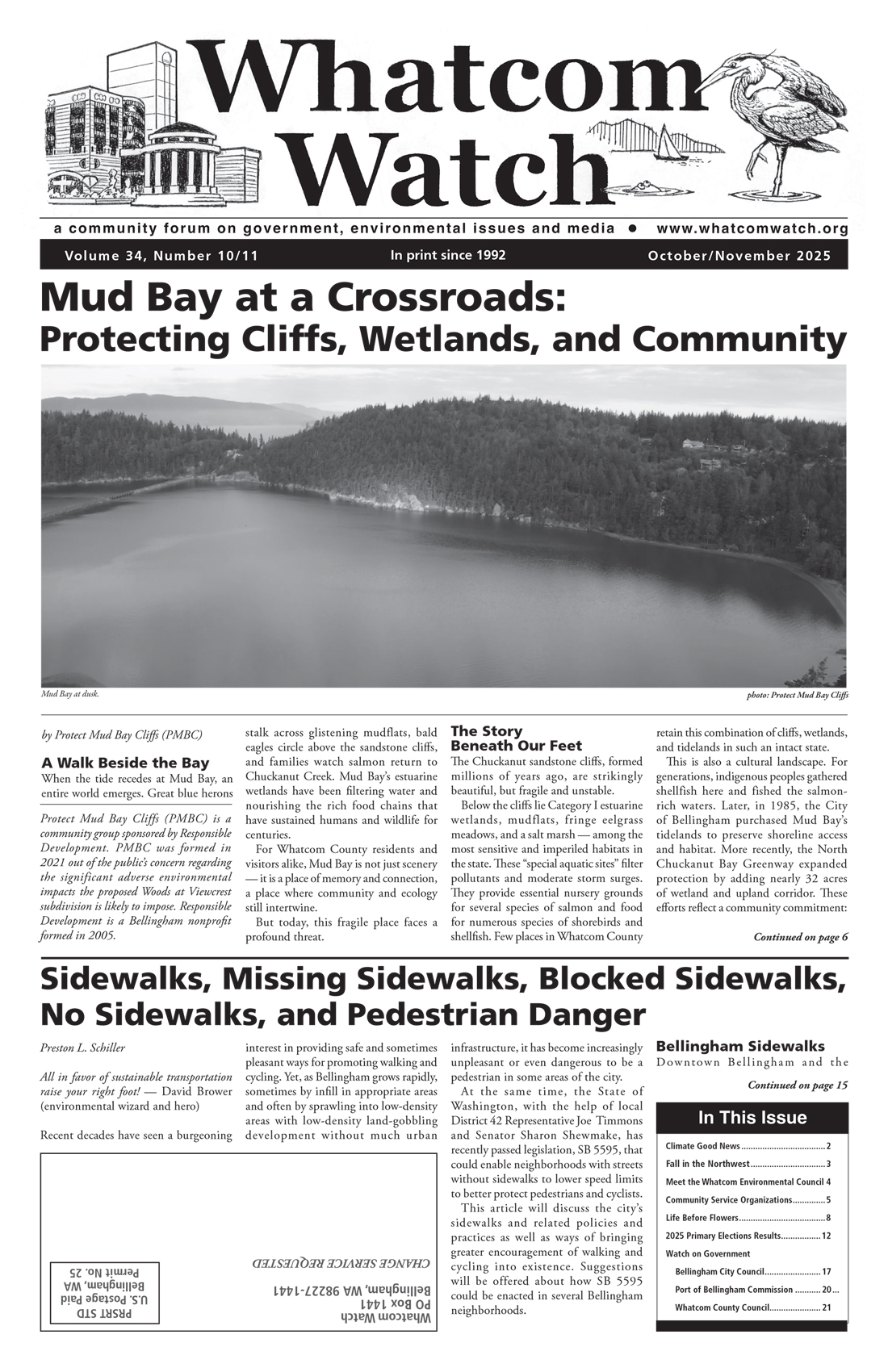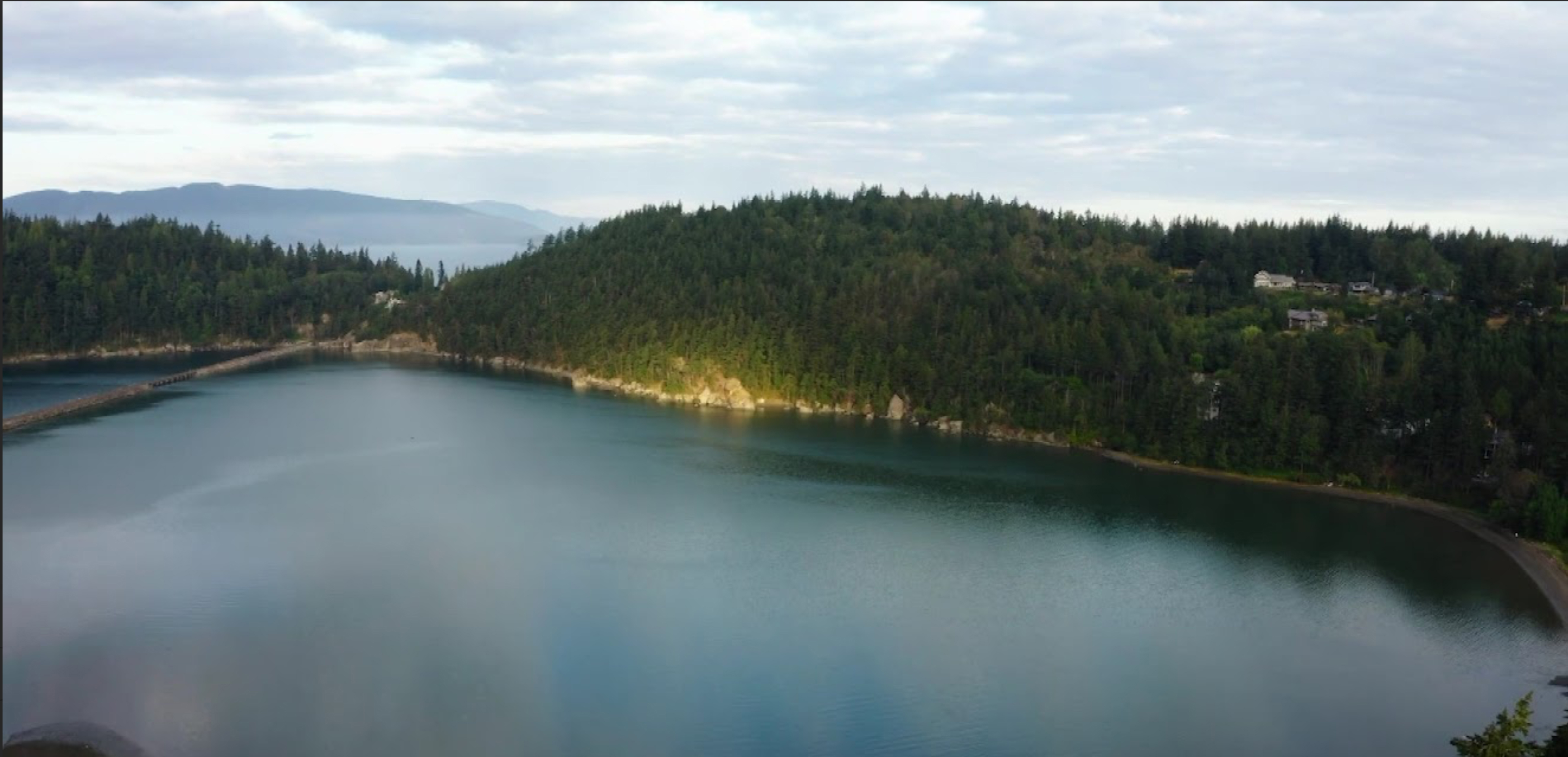
photo: Protect Mud Bay Cliffs
Mud Bay at dawn
A Walk Beside the Bay
When the tide recedes at Mud Bay, an entire world emerges. Great blue herons stalk across glistening mudflats, bald eagles circle above the sandstone cliffs, and families watch salmon return to Chuckanut Creek. Mud Bay’s estuarine wetlands have been filtering water and nourishing the rich food chains that have sustained humans and wildlife for centuries.
For Whatcom County residents and visitors alike, Mud Bay is not just scenery — it is a place of memory and connection, a place where community and ecology still intertwine.
But today, this fragile place faces a profound threat.
The Story Beneath Our Feet
The Chuckanut sandstone cliffs, formed millions of years ago, are strikingly beautiful, but fragile and unstable.
Below the cliffs lie Category I estuarine wetlands, mudflats, fringe eelgrass meadows, and a salt marsh — among the most sensitive and imperiled habitats in the state. These “special aquatic sites” filter pollutants and moderate storm surges. They provide essential nursery grounds for several species of salmon and food for numerous species of shorebirds and shellfish. Few places in Whatcom County retain this combination of cliffs, wetlands, and tidelands in such an intact state.
This is also a cultural landscape. For generations, indigenous peoples gathered shellfish here and fished the salmon rich waters. Later, in 1985, the City of Bellingham purchased Mud Bay’s tidelands to preserve shoreline access and habitat. More recently, the North Chuckanut Bay Greenway expanded protection by adding nearly 32 acres of wetland and upland corridor. These efforts reflect a community commitment: Mud Bay is worth protecting.
Development Proposal
Sadly, Mud Bay’s legacy is now at risk. A subdivision proposal known as The Woods at Viewcrest seeks to subdivide the forested land above and within the sandstone cliffs overlooking Mud Bay into 38 smaller residential lots. Newly adopted development regulations allow the owner of each of these newly created lots to construct multifamily housing with four units. The city is currently updating its accessory dwelling unit (ADU) regulation that will allow each owner to construct two ADUs in addition to the fourplex, increasing the potential density to 228 residences for the proposed subdivision.
On paper, The Woods at Viewcrest (The Woods) may look like any other subdivision. But these sandstone cliffs are not places to be carved into lightly. In reality, plans for The Woods call for rock removal near and within geologically hazardous slopes, clearing steep urban woodlands, and funneling polluted runoff toward fragile estuarine wetlands.
Of the 38 proposed lots, 33 (nearly 90 percent) require city approval for a drastic 80 percent reduction in landslide hazard area (LHA) buffers — from the required 50 feet down to just 10 feet. That’s worth repeating: The plans call for the city to approve exceptions to the standard 50- foot LHA buffer that would reduce buffer widths by 80 percent on nearly 90 percent of the proposed lots. The developer and city claim this will not cause any adverse impact on public safety. (“Move along, nothing to see here.”)
To provide the subdivision’s necessary infrastructure, blasting of the sandstone layers that form the cliffs is anticipated, potentially destabilizing the slopes above the bay.
In addition, stormwater from new roads, rooftops, and driveways would be routed through an indeterminant number undersized Modular Wetland System (MWS) devices, which are intended to partially filter the polluted runoff. While these devices may catch a portion of some pollutants, they cannot remove them all. During major storms, the fast-moving stormwater flowing down the steep slopes can exceed the capacity of the MWS devices and will completely bypass treatment, resulting in the direct discharge of untreated stormwater into Mud Bay’s environmentally sensitive estuary.
Crucially, these modular wetlands do not treat 6PPD-quinone, a chemical from vehicle tires now known to be lethal to salmon even at trace levels. Excavating and denuding large sections of urban forest within the developed area would further alter its hydrology, reduce natural infiltration and evapotranspiration, and result in greater runoff, less groundwater recharge, and weaker slopes.
For a place as fragile and unique as Mud Bay, these risks are not theoretical. They are immediate and irreversible.
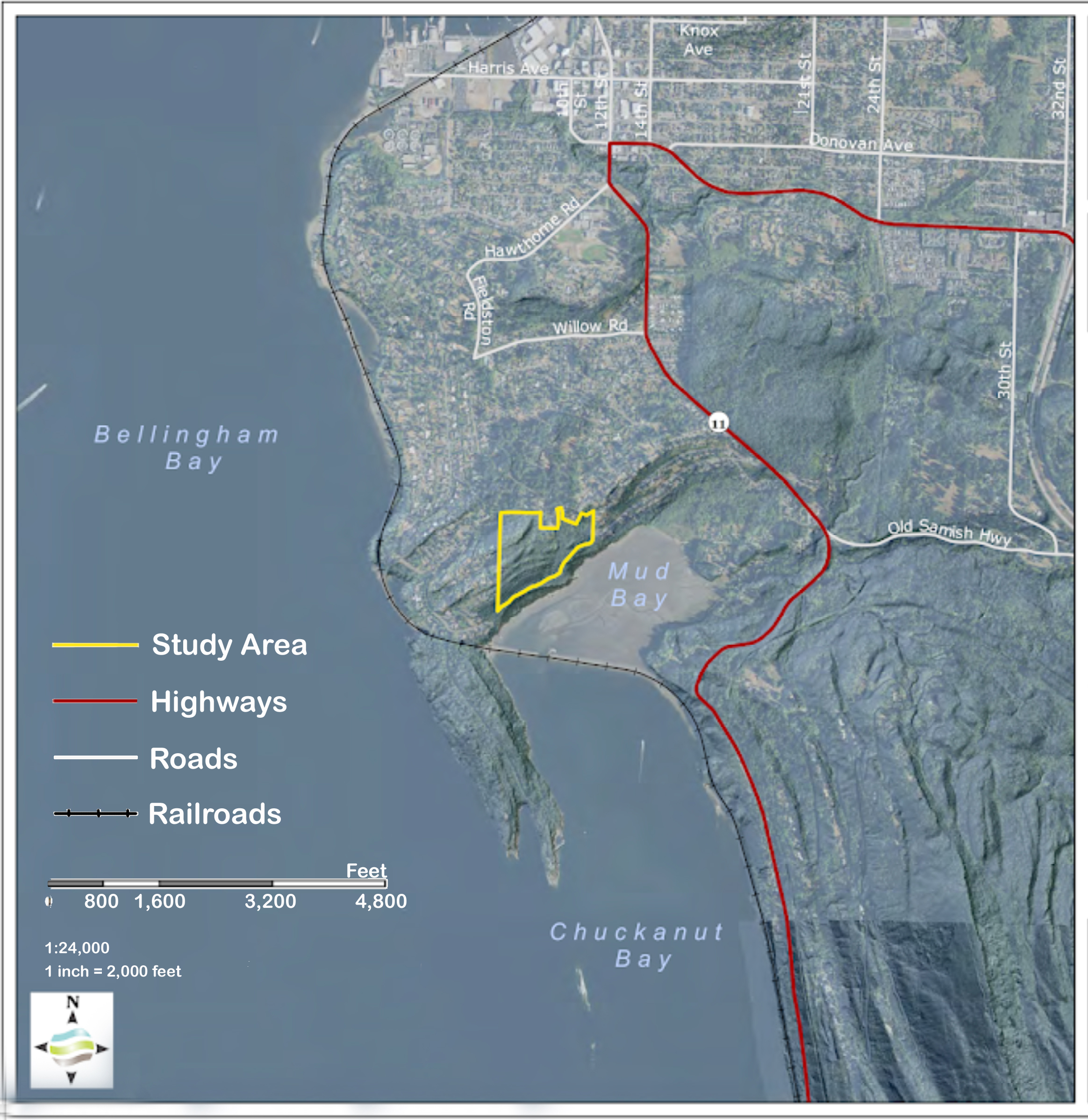
What’s at Stake?
The impacts of this project ripple across multiple dimensions:
- Landslides and Blasting Hazards: Blasting sandstone cliffs threatens slope stability. Landslides could damage homes, the highly popular Chuckanut Creek Shoreline Trail at the base of the cliffs, and fragile habitats within the mudflats, wetlands, and salt marsh. The potential for severe injury to shoreline visitors is dramatically increased.
- Stormwater Pollution: The MWS manufacturer’s own data show only partial pollutant removal: 23 percent for nitrogen, 37 percent for dissolved copper, 50 percent for total copper. Meanwhile, 6PPD-quinone — which is deadly to salmon — would flow untreated into Mud Bay.
- Tree Loss and Hydrology: Removing mature forest reduces natural water absorption and slope stability, increasing the risk of flooding and erosion.
- Wildlife Habitat: Eagles, herons, migrating shorebirds, salmon, and shellfish all depend on Mud Bay’s interconnected habitats.
- Wildlife Corridor: The woodlands abutting Mud Bay serve as vital wildlife corridor, linking the rich ecosystems of Clark’s Point with the expansive Chuckanut Forest. This currently pristine stretch of land offers safe passage for deer, birds, and countless other species, preserving biodiversity and ecological balance. Protecting it ensures that this natural connection remains undisturbed for generations to come.
- Community Recreation and Livability: The shoreline trail, tidelands, and open water of Mud Bay are actively used by residents countywide, as well as visitors from afar. In short, the costs incurred by approving this perilous subdivision would be borne not only by the environment but by our local community.
Legal and Regulatory Fight
Under Washington’s State Environmental Policy Act (SEPA), if there is a reasonable likelihood that a project will impose more than a moderate adverse impact on environmental quality, then a full Environmental Impact Statement (EIS) shall be required.
When determining whether an EIS should be prepared, SEPA requires that the physical location of the project be taken into account, and that the combination of adverse impacts be considered together.
Additionally, when potential impacts would be severe — as in the case of a landslide or rockslide into the Mud Bay estuary — even if the chance of occurrence is not great, then an EIS is required.
An EIS ensures that risks are fully studied, alternatives are considered, and the public has a clear record of the trade-offs involved and an opportunity to weigh in.
Despite all evidence that an EIS for The Woods is required because the adverse environmental impacts will be significant, on July 25, 2025, the City of Bellingham chose not to require an EIS. The city claims the developer has shown the project will cause no net loss of shoreline ecological function with some minimal proposed mitigation measures, and a more thorough environmental impact review is not needed.
Protect Mud Bay Cliffs (PMBC), a countywide community group, has legally appealed to reverse the city’s decision. PMBC argues that an EIS is essential because:
- The developer’s application and technical reports don’t provide adequate information and data to evaluate impacts.
- The proposed subdivision doesn’t comply with city, state, and federal environmental standards.
- Certain impacts to habitat, property, and public safety — including the adverse consequences from blasting, potential slope failure, and stormwater toxins — cannot be mitigated at all.
- Without a full EIS, the community cannot have confidence that Mud Bay will be protected.
Bottom line: The risks are simply too great for the city to accept such drastic shortcuts. Only a full EIS can evaluate blasting hazards, stormwater toxins, long-term slope stability, increased flooding, and the public safety of pedestrians, cyclists, motorists and pets in a transparent way. Without an EIS, the city is gambling with safety, water quality, and public trust.
The SEPA appeal is now moving forward, and the outcome will determine whether the law requires a comprehensive environmental review before bulldozers and rock breakers begin carving the cliffs. The SEPA appeal hearing before the City of Bellingham Hearing Examiner is scheduled for January 12 through January 16, 2026.
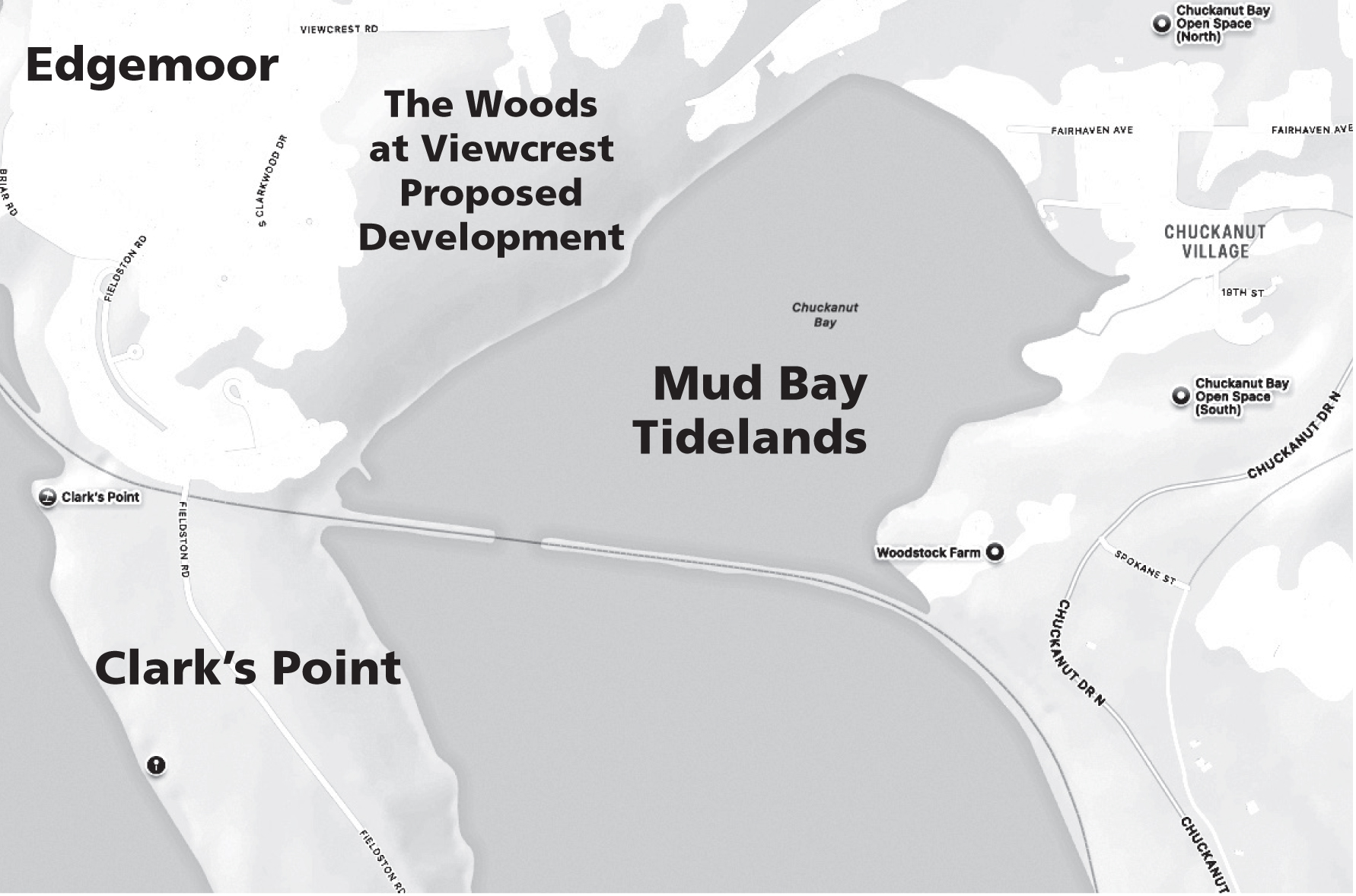
credit: Apple map
Community Voices
For county residents and far flung visitors alike, the impacts and risks are personal. Residents living nearby the proposed development worry about their homes and their safety if blasting destabilizes the cliffs. Others fear the loss of the trails, trees, and wildlife they’ve cherished for decades.
As one longtime resident said, “For decades, I’ve watched eagles nest in the cliffs and salmon return to the creek. I can’t imagine bulldozers tearing this place apart.”
A kayaker who regularly paddles in Mud Bay described it this way: “This is the only place I find quiet in a busy city. Out here you feel the tide breathing, like the bay itself is alive.”
For many, the question is about the legacy we leave. According to one resident, “This is not just about us. It’s about the next generation. Will they inherit an intact shoreline or a degraded one?”
Mud Bay is not an abstract issue. It is a living estuary and a daily refuge for people across the county and for the visitors our area attracts. Protecting Mud Bay and the upland Mud Bay Cliffs means protecting the heart of a community.
Bigger Picture
What’s happening in Mud Bay reflects a larger dilemma: how does a growing city like Bellingham balance development pressure with ecological limits?
Washington’s recent zoning reforms and Bellingham’s upcoming Comprehensive Plan update push the city toward greater density. Yet density without limits and enforcement of existing regulations can become just another form of overreach if fragile ecosystems are treated as expendable.
Mud Bay is a reminder that growth cannot always mean building more, bigger, and faster. At some point, carrying capacity matters. Ecological overshoot is not just a global concept. It plays out right here, in the balance between cliffs, wetlands, and stormwater.
The Woods at Viewcrest is more than a local fight. Its a litmus test for Bellinghams future: Will we respect ecological limits? Or will we sacrifice irreplaceable places for irresponsible development? Your participation in the process can help our city navigate the right balance between growth and preservation of a unique resource.
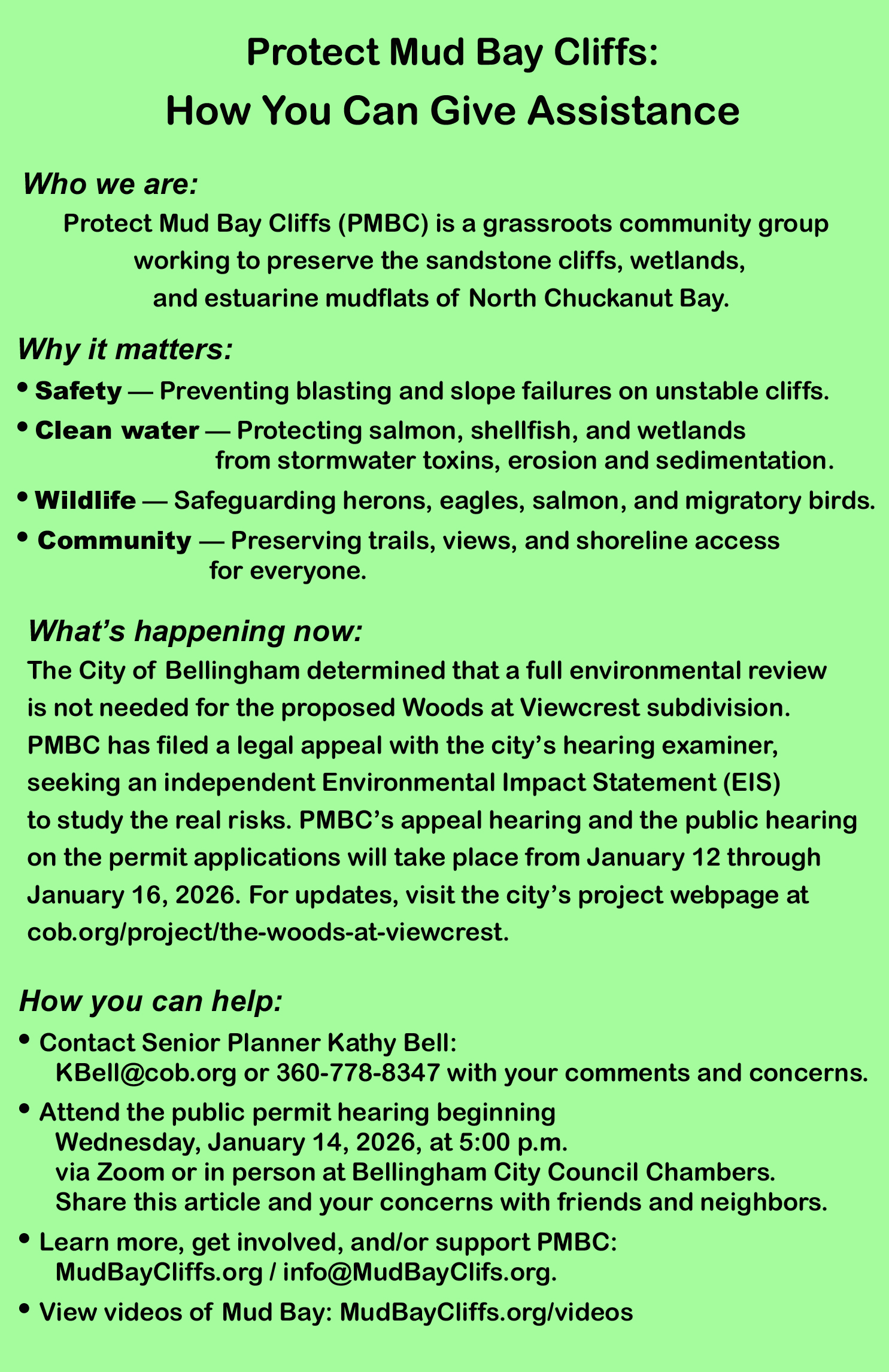
Call to Action
When those of us who love Mud Bay return to the shoreline at low tide, we are reminded why this place matters. The tidal flats gleam, herons feed in the shallows, ravens call across the bay, and the cliffs stand as silent witnesses to millions of years of natural history. For now, Mud Bay and its estuary endure, but their future hangs in the balance.
We have a choice: safeguard it now, or lose it forever.
Protect Mud Bay Cliffs has a strong heritage. Many PMBC members have been involved with Responsible Development, a 501(c)(3) nonprofit that was instrumental in preserving the cherished Hundred Acre Wood property nearly two decades ago. Responsible Development is still pursuing its mission to preserve the ecology of Whatcom County and is serving as PMBC’s financial sponsor.
Protect Mud Bay Cliffs and Responsible Development are committed to ensuring that future generations continue to enjoy all that Mud Bay has to offer, to hear the same bird calls, and to feel the same sense of refuge. But we cannot do it alone.
If you care about Mud Bay — about clean water, safe slopes, thriving wildlife, and community heritage — now is the time to act. Your voice will make a difference.
Visit MudBayCliffs.org to learn more and receive the latest updates. Then please email your heartfelt comments to the city. Consider attending the upcoming hearing on January 12. And spread the word to friends and family. Our website details the easy steps how.
Together, let’s ensure that Mud Bay remains what it has always been: a place of beauty, a living estuary, and a resource for future generations of our community.
________________________________________
Protect Mud Bay Cliffs (PMBC) is a community group sponsored by Responsible Development. PMBC was formed in 2021 out of the public’s concern regarding the significant adverse environmental impacts the proposed Woods at Viewcrest subdivision is likely to impose. Responsible Development is a Bellingham nonprofit formed in 2005.

